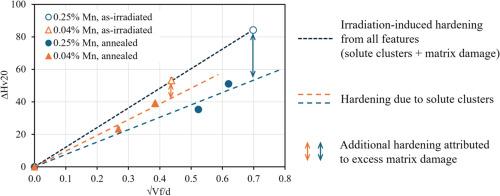低合金钢辐照后退火研究:确定基体损伤和聚类对硬化的贡献
IF 3.2
2区 工程技术
Q3 MATERIALS SCIENCE, MULTIDISCIPLINARY
引用次数: 0
摘要
在这项工作中,在高达425℃的温度下对两种不同Mn含量的低cu钢进行了辐照后退火(PIA),辐照剂量高达0.1 dpa。原子探针断层扫描(APT)用于表征辐照材料和选择PIA样品中簇的数量、大小和组成,并将结果与辐照引起的硬度变化进行比较。对于这两种钢,发现随着退火温度的升高,Mn和Si从团簇中溶解到周围的基体中。团簇的数量密度和体积分数随退火温度的升高而降低。正如粒子硬化模型所预期的那样,由于辐照引起的硬度变化与PIA材料的簇尺寸归一化的簇体积分数的平方根成正比。然而,辐照后的材料却偏离了这一趋势。研究人员提出,观察到的辐照材料高于预期的硬化是由不稳定基体损伤引起的,而不稳定基体损伤不能用APT直接表征。本文章由计算机程序翻译,如有差异,请以英文原文为准。

Post-irradiation annealing study on low-alloy steels: Determining the contributions of matrix damage and clustering to hardening
In this work, post-irradiation annealing (PIA) at temperatures up to 425 °C was carried out on two low-Cu steels with varying Mn content that were irradiated at high flux to doses up to ∼0.1 dpa. Atom probe tomography (APT) was used to characterise the number, size, and composition of clusters in the as-irradiated material and select PIA samples, and the results compared alongside irradiation-induced change in hardness. For both steels it was found that as annealing temperature increased there was dissolution of Mn and Si from the clusters into the surrounding matrix. The number density and volume fraction of clusters were found to decrease with increasing annealing temperature. As expected from particle hardening models, the change in hardness due to irradiation was proportional to the square root of cluster volume fraction normalised by cluster size for the PIA material. The as-irradiated material, however, deviated from this trend. It is proposed that the observed increase above the expected hardening for the as-irradiated material is attributed with unstable matrix damage, which cannot be directly characterised by APT.
求助全文
通过发布文献求助,成功后即可免费获取论文全文。
去求助
来源期刊

Journal of Nuclear Materials
工程技术-材料科学:综合
CiteScore
5.70
自引率
25.80%
发文量
601
审稿时长
63 days
期刊介绍:
The Journal of Nuclear Materials publishes high quality papers in materials research for nuclear applications, primarily fission reactors, fusion reactors, and similar environments including radiation areas of charged particle accelerators. Both original research and critical review papers covering experimental, theoretical, and computational aspects of either fundamental or applied nature are welcome.
The breadth of the field is such that a wide range of processes and properties in the field of materials science and engineering is of interest to the readership, spanning atom-scale processes, microstructures, thermodynamics, mechanical properties, physical properties, and corrosion, for example.
Topics covered by JNM
Fission reactor materials, including fuels, cladding, core structures, pressure vessels, coolant interactions with materials, moderator and control components, fission product behavior.
Materials aspects of the entire fuel cycle.
Materials aspects of the actinides and their compounds.
Performance of nuclear waste materials; materials aspects of the immobilization of wastes.
Fusion reactor materials, including first walls, blankets, insulators and magnets.
Neutron and charged particle radiation effects in materials, including defects, transmutations, microstructures, phase changes and macroscopic properties.
Interaction of plasmas, ion beams, electron beams and electromagnetic radiation with materials relevant to nuclear systems.
 求助内容:
求助内容: 应助结果提醒方式:
应助结果提醒方式:


